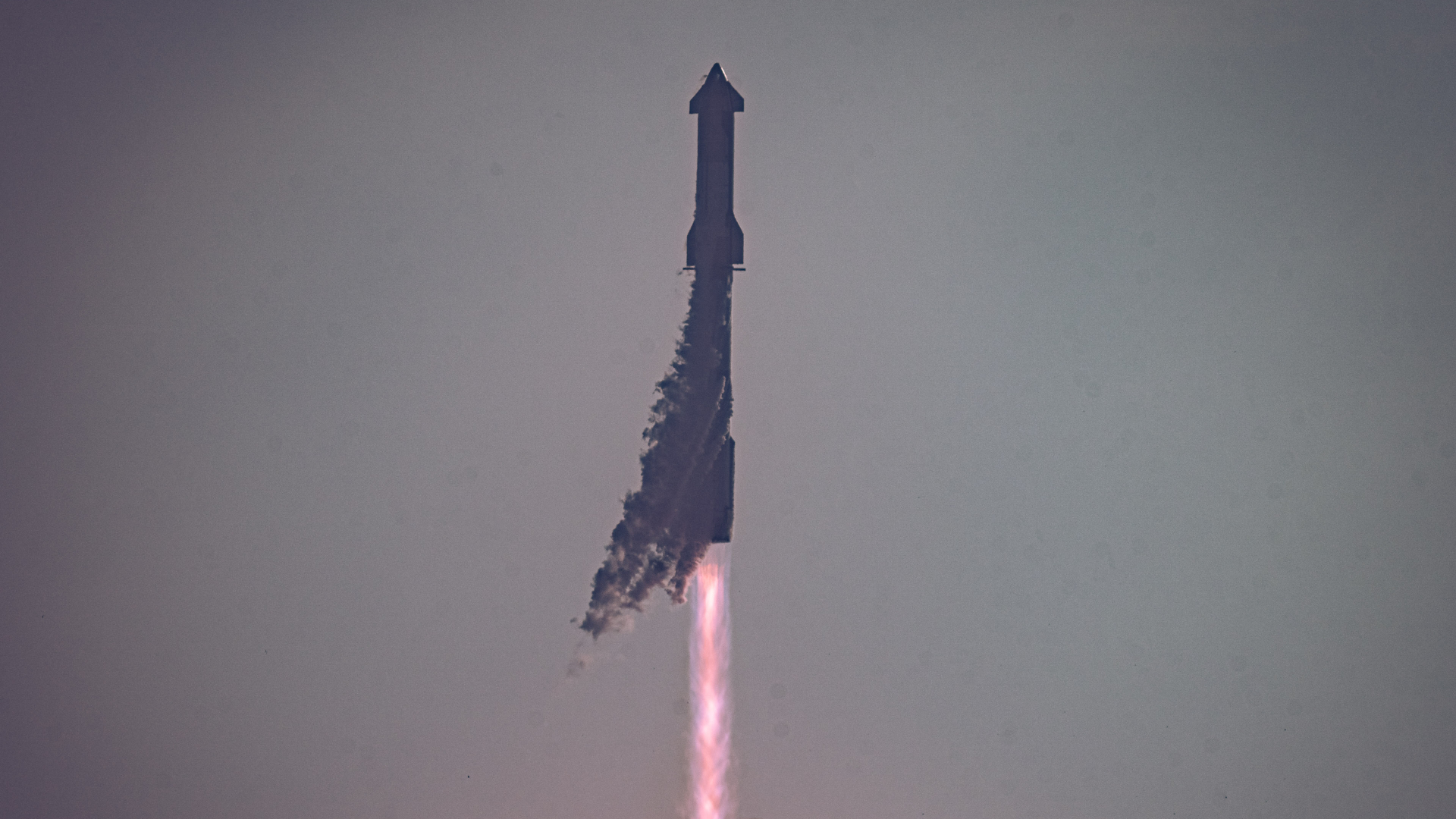
SpaceX has submitted to the U.S. Federal Aviation Administration (FAA) its final report about the debut launch of its Starship vehicle, which ended with a bang four minutes after liftoff.
SpaceX launched a fully stacked Starship for the first time ever on April 20, sending the giant rocket-spacecraft combo aloft from its Starbase site in South Texas.
The test flight aimed to get Starship's upper stage partway around Earth, with splashdown targeted for a patch of the Pacific Ocean near Hawaii. But that didn't happen; Starship's two stages didn't separate as planned, and SpaceX beamed up a self-destruct command, which resulted in the vehicle's detonation high above the Gulf of Mexico.
Related: Relive SpaceX's explosive 1st Starship test in incredible launch photos
The launch also caused considerable damage at Starbase, blasting out a crater beneath the site's orbital launch mount and raining chunks of concrete and other debris on the surrounding area.
SpaceX soon initiated a mishap investigation — overseen by the FAA, which issues launch licenses — to determine exactly what happened on April 20 and what steps to take to boost the chances of a more successful outcome in the future.
Elon Musk's company has now filed that report, as Payload noted yesterday (Aug. 15). But that doesn't mean Starship has been cleared to fly again.
Breaking space news, the latest updates on rocket launches, skywatching events and more!
"SpaceX has submitted its final mishap investigation report to the FAA for review. That review is ongoing," FAA officials said in an emailed statement to Space.com.
"When a final mishap report is approved, it will identify the corrective actions SpaceX must make," the statement added. "Separately, SpaceX must modify its license to incorporate those actions before receiving authorization to launch again."
SpaceX has already taken some corrective actions. For example, Elon Musk's company recently installed a water deluge system beneath Starbase's orbital launch mount, to dampen the immense power of Starship's giant Super Heavy first stage.
That system — a steel plate that sprays huge amounts of water upward and outward — got its first real test on Aug. 6, during a "static fire" test of the Super Heavy prototype known as Booster 9.
SpaceX is prepping Booster 9 and an upper-stage vehicle called Ship 25 for Starship's second full-up test flight, whose aims will be similar to the April 20 try.
Shortly after that first flight, Musk said that SpaceX should be ready to launch another Starship mission in six to eight weeks — a timeline that could allow for liftoff any day now. But don't hold your breath; logistical hurdles still need to be cleared regardless of the technical progress that SpaceX has made.
The FAA is still reviewing the mishap report, for example. In addition, a coalition of environmental and Indigenous groups is currently suing the agency, claiming it didn't properly assess the damage that Starship launches could cause to the South Texas ecosystem and community.
Join our Space Forums to keep talking space on the latest missions, night sky and more! And if you have a news tip, correction or comment, let us know at: community@space.com.

Michael Wall is a Senior Space Writer with Space.com and joined the team in 2010. He primarily covers exoplanets, spaceflight and military space, but has been known to dabble in the space art beat. His book about the search for alien life, "Out There," was published on Nov. 13, 2018. Before becoming a science writer, Michael worked as a herpetologist and wildlife biologist. He has a Ph.D. in evolutionary biology from the University of Sydney, Australia, a bachelor's degree from the University of Arizona, and a graduate certificate in science writing from the University of California, Santa Cruz. To find out what his latest project is, you can follow Michael on Twitter.
-
rocketwatcher I’m curious about what they said about the FTS (Flight Termination System) failures. To my knowledge, the U.S. has never had a Flight Termination System failure of this magnitude before. The self destruct command was sent, and the system only partially activated, and it didn’t work correctly. I have not seen a lot of press coverage of the FTS failures, but I imagine that this is being examined by the FAA in great detail.Reply -
Toado Reply
The flight termination system worked, it just worked far too slowly. No question at all about that, nor does this require a major engineering fix.rocketwatcher said:I’m curious about what they said about the FTS (Flight Termination System) failures. To my knowledge, the U.S. has never had a Flight Termination System failure of this magnitude before. The self destruct command was sent, and the system only partially activated, and it didn’t work correctly. I have not seen a lot of press coverage of the FTS failures, but I imagine that this is being examined by the FAA in great detail.
It did not "partially activate" it fully activated it can clearly be seen in the video activating on both tanks fine. It just took the seemingly over built rocket far too long to blow up thereafter. A very easy fix ,I would have thought, blowing more holes in tanks is not complicated.
The recent static fire seems to have validated the deluge system, though we have yet to see a full power test with all the engines running. I suspect it will hold up to all intents and purposes and it seems to have cleared up the major debris problems as well.
Far more important is why Starship has yet to have x 33 engines running simultaneously on the booster.
The lost development and particularly testing time on the booster, thanks to FAA delays, may well have hampered the project quite badly. Elon's fault for tweaking their tail by launching without a FAA Inspector on site.
The FAA will delay and delay yet again, because they really are not fit for purpose when it comes to this type of hardware rich development program.
Those are the real problems, not the FTS which is an easy fix. -
Unclear Engineer Question: Why was an FAA inspector not on-site at the launch? It is not as if the launch was any sort of a surprise. Did the FAA simply not provide an inspector at the proper time and then expect the whole world to wait for them to get around to it?Reply -
rocksnstars Reply
There was/has not been a lot of coverage of the FTS failure, the environmental lawsuit (which obviously has merit based on the results of the first launch), or SpaceX's failure to obtain a required permit "...to dump a vast amount of industrial wastewater into sensitive wetlands on a national wildlife refuge..." (San Antonia News-Express, 8/16/2023) prior to the recent static hot fire test. There is not a lot of negative press coverage about SpaceX. Perhaps that is due to a combination of Musk's billions and NASA's successful manned lunar landing per schedule based on their complete reliance of the Starship. The FAA proved unreliable with the Boeing 737 MAX disaster which resulted in the death of 346 people. Perhaps that, plus the results of the first Starship launch, will cause the FAA to be more critical in approving a second launch, and perhaps their fellow government agency, NASA, will allow the FAA to do it's job. The EPA should have been involved in the original approval, but it's easier to obtain forgiveness than permission.rocketwatcher said:I’m curious about what they said about the FTS (Flight Termination System) failures. To my knowledge, the U.S. has never had a Flight Termination System failure of this magnitude before. The self destruct command was sent, and the system only partially activated, and it didn’t work correctly. I have not seen a lot of press coverage of the FTS failures, but I imagine that this is being examined by the FAA in great detail. -
Unclear Engineer The environmental aspect of what SpaceX is doing can never be zero negative effect on anything anywhere. It is an industrial activity. It has annoyed me many times to see "environmentalists" arguing that someplace is important to some species and thus should be off limits to anything (except their personal intrusions to recreate in the area), while, at the same time, cities are putting in new roads, shopping centers, housing developments that actually affect very similar ecosystems to a much greater negative extent.Reply
The real issue is whether allowing SpaceX to use this area is worth the degradation levels that will need to occur. Considering how few areas are available for launching something like Super Heavy over water instead of land, it seems to me that all we can really call for is that SpaceX makes reasonable efforts to limit ecological effects. But, a lot of the "environmentalist" resistance is mainly a reflection of "not in my backyard", and so no level of effect is OK. This is especially true for the Native American claim of "sacred lands", too.
So, the courts are going to have to decide if they want to become a never ending impediment to SpaceX rocket development or make a prompt and decisive decision that the benefits to society outweigh the disbenefits to society. -
Invertebrate Mike excellent article. To me the FTS works, or it doesn't work; I would think a delay in seconds could cause more damage it the rockets deviates over land or the sensitive wetlands. But I do understand ability to fix, but broke is broke. Looking at the large 300 BBL white tanks six pack tanks that are very near the pad. Do these tanks store the deluge water or do they contain something else. The bullet tanks that are near also must contain the methane or the LOX they are still close. Does the launch site have correct separation between fuel storage and the launch site if there is a failure on the pad resulting in an explosion? The FAA is the lead agency on launch authorization, but I doubt they have biologist on their staff that can access the impacts of the site 's toxic runoff into the wetlands, or damage that was caused to the wetlands from the April launch attempt. They FAA probably would not know a Kemp Ridley from an explosive squib, both have hard shells. The petroleum industry would call the first launch attempt a NEAR MISS, and many lessons to be learned. Elon has got to get it right next trip.Reply
